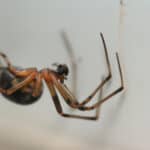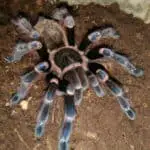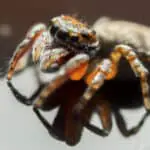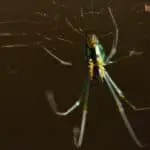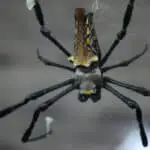As a homeowner, you take pride in maintaining a beautiful lawn. However, spider webs on your grass can be unsightly and make you hesitant to spend time outdoors. Not to mention, spider webs can also indicate an underlying issue with your lawn’s health. In this article, I will share with you some tips on how to get rid of spider webs on grass and prevent them from returning.
Understanding spiders in your lawn is the first step in getting rid of their webs. Spiders are attracted to areas with abundant insects, which is why they often make their homes in lawns. While most spiders are harmless, their webs can make your lawn look unkempt and even pose a tripping hazard. Identifying spider webs on grass is also important, as some webs may be indicative of a more serious fungal issue that requires treatment. In this article, I will help you identify different types of spider webs and provide solutions for removing them.
Key Takeaways
- Spiders are attracted to areas with abundant insects, which is why they often make their homes in lawns
- Identifying spider webs on grass is important, as some webs may be indicative of a more serious fungal issue that requires treatment
- Regular lawn maintenance, such as mowing and watering, can help prevent spider webs from forming on your grass
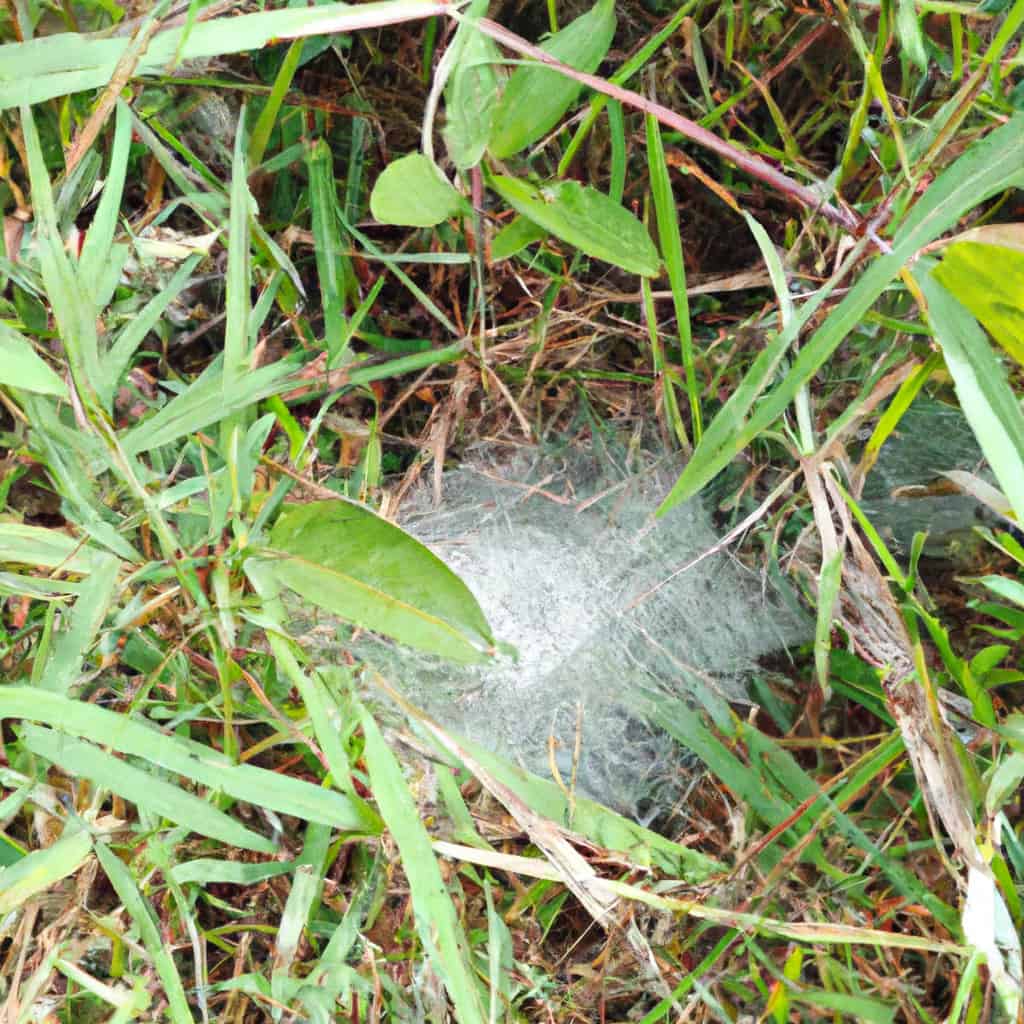
Understanding Spiders in Your Lawn
As the summer months approach, it’s common to see spider webs on your lawn. But why do spiders make their homes in your grass, and how can you identify them?
There are several types of spiders that may make their homes in your lawn, including grass spiders, garden spiders, and funnel-web spiders. These spiders are typically harmless to humans and can even help control insect populations in your yard.
Male and female spiders may look different, with males being smaller and less colorful in some species. Agelenidae, also known as funnel-web spiders, are known for their distinctive webs that resemble funnels.
Spiders may seek shelter in your lawn for a variety of reasons, including protection from predators and access to food sources. Grass spiders, in particular, may build their webs close to the ground to catch insects like grasshoppers and crickets.
If you’re concerned about spiders in your lawn, it’s important to properly identify them before taking any action. In some cases, spiders may actually be beneficial to your yard’s ecosystem.
In the next section, we’ll explore some tips for safely and effectively removing spider webs from your lawn.
Identifying Spider Webs on Grass
If you’ve noticed silvery strands on your grass, it’s likely that you have spider webs on your lawn. These webs are not from spiders, but from a much tinier life-form called grass spiders. Grass spiders are beneficial because they catch and eat insects that feed on lawn grass. However, if you’re concerned about the appearance of spider webs on your grass, there are ways to get rid of them.
Grass spider webs are typically funnel-shaped and easy to identify because the spider will still be there! Grass spiders rarely leave their webs and like to hide in the funnel shelter part of their sheet-like web. They like to eat pesky insects that feed on turfgrass and prefer to run and hide instead of confronting humans.
It’s important to note that not all spider webs on grass are from grass spiders. Other types of spiders may also make webs on grass, such as cobweb spiders or funnel weaver spiders. These spiders may make different types of webs, but they are also beneficial because they catch and eat insects that feed on lawn grass.
If you’re unsure whether the webs on your grass are from grass spiders, look for cone-shaped spider webs in the grass. The spiders like to hide in a part of the web sheltered by fallen leaves, rocks, or debris. They quickly run to another part of the web when disturbed, and they can deliver a painful, but otherwise harmless, bite.
Overall, identifying spider webs on grass is relatively easy. If you’re not sure whether the webs on your grass are from grass spiders or another type of spider, look for cone-shaped webs and observe the behavior of the spiders. Remember that spiders are beneficial because they catch and eat insects that feed on lawn grass. However, if you’re concerned about the appearance of spider webs on your grass, there are ways to get rid of them.
Why Spiders Are Attracted to Your Lawn
As much as we may not like them, spiders play an important role in our ecosystem. They are natural pest controllers, feeding on insects such as aphids, flies, and beetles. So, it’s no surprise that they are attracted to our lawns, which are often teeming with insects.
But why do spiders spin webs on our lawns? One reason is to catch prey. Spiders spin their webs in areas where insects are likely to fly or crawl, such as near outdoor lighting or in areas with tall grass. The webs act like a trap, catching the insects as they move through the area.
Another reason spiders are attracted to our lawns is food particles. If you have pets that eat outside, or if you frequently have outdoor gatherings, food particles can attract insects, which in turn attract spiders. Additionally, pet food left outside can also attract spiders.
It’s important to note that spiders are not attracted to dirty or unkempt lawns. In fact, maintaining a well-manicured lawn can help reduce the number of spiders on your property. By keeping the grass short and removing any debris or brush piles, you can make your lawn less attractive to spiders.
In summary, spiders are attracted to our lawns because of the abundance of insects and food particles. By maintaining a clean and well-manicured lawn, you can reduce the number of spiders on your property.
The Impact of Spider Webs on Lawn Health
As a homeowner, you may have noticed spider webs appearing on your lawn. But what impact do these webs have on your lawn’s health? Let’s take a closer look.
First, it’s important to note that not all spider webs are harmful. Grass spiders, for example, are beneficial because they catch and eat insects that feed on lawn grass. However, other types of spider webs can be a sign of underlying issues.
Mycelium, a type of fungi, can appear as tiny web-like threads on grass blades. While not harmful to humans, mycelium can indicate heavy thatch or overwatering, which can lead to brown spots on your lawn. In this case, it’s important to address the underlying issue to prevent further damage to your lawn.
Another potential issue is the presence of dollar spot fungus, which can also appear as spider webs on your lawn. This fungus can cause small brown spots on your lawn and weaken the grass blades. If left untreated, it can spread and cause larger areas of damage.
In summary, while not all spider webs are harmful, they can be a sign of underlying issues that may impact your lawn’s health. It’s important to identify the cause of the spider webs and address any underlying issues to prevent further damage to your lawn.
How to Get Rid of Spider Webs
If you have spider webs on your grass, it’s important to remove them to prevent spiders from infesting your lawn. Here are some ways to get rid of spider webs on grass:
- Use a broom: One of the easiest ways to remove spider webs from grass is to use a broom. Simply sweep the webs away gently, being careful not to damage the grass.
- Spray with water: Another way to remove spider webs from grass is to spray them with water. Use a garden hose or a spray bottle to wet the webs, and then gently wipe them away with a cloth or paper towel.
- Use spider repellent: If you have a spider problem on your lawn, you may want to use a spider repellent to keep them away. Look for a natural spider repellent that contains essential oils like peppermint, which spiders hate.
- Wear gloves: When removing spider webs from grass, it’s a good idea to wear gloves to protect your hands. This will also prevent any spiders from crawling onto your skin.
- Use diatomaceous earth: Diatomaceous earth is a natural substance that can help to get rid of spiders on your lawn. Simply sprinkle it over the affected area, and the spiders will avoid it.
By following these tips, you can get rid of spider webs on your grass and prevent spiders from infesting your lawn.
Preventing Spider Webs on Your Lawn
As a homeowner, you want to keep your lawn looking great and free from pests like spiders. Here are some tips to help prevent spider webs from taking over your lawn:
- Regular Lawn Maintenance: Regular lawn maintenance is key to preventing spider webs on your lawn. Keeping your lawn well-maintained by mowing it to the correct height and fertilizing it regularly will help prevent spiders from building webs.
- Remove Debris: Spiders love to build their webs in areas with debris, so make sure to keep your lawn free from leaves, twigs, and other debris.
- Trim Vegetation: Spiders also like to build their webs in overgrown vegetation, so make sure to trim bushes, shrubs, and trees regularly.
- Use Pesticides: If you have a serious spider problem, you may need to use pesticides to get rid of them. However, be sure to use pesticides in a responsible manner and follow all instructions on the label.
- Repel Spiders with Mint or Rosemary: Spiders are repelled by the smell of mint and rosemary, so planting these herbs in your garden can help keep spiders away.
- Get Rid of Grass Spiders: Grass spiders are a common type of spider that like to build their webs in lawns. To get rid of grass spiders, you can simply remove their webs and relocate them to another area away from your lawn.
By following these tips, you can help prevent spider webs from taking over your lawn and keep your lawn looking great all year round.
Understanding and Dealing with Grass Spider Bites
As with any spider bite, it’s important to take proper precautions when dealing with grass spider bites. While grass spiders are not considered venomous, their bites can still be painful and cause irritation.
If you are bitten by a grass spider, the first step is to clean the affected area with soap and water. Apply a cold compress to reduce swelling and pain. If the bite becomes infected or you experience severe symptoms such as difficulty breathing or swelling of the face, seek medical attention immediately.
It’s important to note that not all brown spiders are venomous, and not all venomous spiders are brown. While grass spiders are typically brown and have a distinctive funnel-shaped web, it’s important to identify the spider before assuming it is venomous.
To prevent grass spider bites, take steps to reduce spider populations in and around your home. Keep your lawn well-maintained by mowing frequently and trimming vegetation. Seal cracks and crevices in your home to prevent spiders from entering. Avoid leaving food or spills out for extended periods, as this can attract insects that spiders feed on.
In the event that you do encounter a grass spider, remember that they are beneficial to the ecosystem and help control insect populations. If possible, try to relocate the spider rather than killing it.
The Role of Spiders in Your Lawn’s Ecosystem
As much as we may not like spiders, they play an essential role in maintaining a healthy ecosystem in our lawns. Spiders are predators that feed on insects, including harmful ones that can damage our grass. By controlling the insect population, spiders help maintain a balance in the ecosystem, which is crucial for the health of our lawns.
While some spiders may seem scary, most are harmless to humans and pets. Grass spiders, for example, are common in lawns and are not venomous. They build funnel-shaped webs that trap insects, including harmful ones like ants and flies, which they then feed on.
Having spiders in your lawn can help reduce the need for pesticides, which can harm both beneficial and harmful insects. By avoiding the use of pesticides, you can help maintain a healthy balance in your lawn’s ecosystem and support the spider population.
In conclusion, spiders play an important role in maintaining a healthy ecosystem in our lawns. By controlling the insect population, they help keep our grass healthy and reduce the need for harmful pesticides. So, the next time you see a spider in your lawn, remember that they are doing their part to keep your lawn healthy and thriving.
Additional Tips and Tricks
When it comes to getting rid of spider webs on your lawn, there are some additional tips and tricks that can help. Here are a few things to keep in mind:
- Keep your lawn well-maintained: Regularly mowing your lawn, trimming vegetation, and removing brush piles can help prevent spiders from making their homes in your yard. Additionally, keeping your lawn healthy with the right fertilizer and watering schedule can deter spiders from taking up residence.
- Use yellow bulbs: Spiders are attracted to light, but they are less likely to be attracted to yellow bulbs. Consider using yellow outdoor light bulbs to keep spiders away.
- Clean up spills and food messes promptly: Spiders are attracted to food, so keeping your outdoor eating areas clean can help prevent them from setting up shop in your yard.
- Check crawl spaces: If you have crawl spaces under your home or deck, make sure to check them regularly for spider webs. Spiders love dark, enclosed spaces, so these areas can be prime real estate for them.
- Be cautious of wolf spiders: While grass spiders are generally harmless, wolf spiders can be more dangerous. If you see wolf spiders in your yard, it may be best to call in a pest control professional for treatment.
- Consider using a fungicide: If you are dealing with mycelium on your lawn, a fungicide may be necessary to get rid of it. Be sure to follow the instructions carefully to avoid damaging your lawn.
By following these additional tips and tricks, you can help keep your lawn spider-free and enjoy your outdoor space without fear of cobwebs or creepy crawlies.
Frequently Asked Questions
How to remove spider webs from grass without harming the environment?
Removing spider webs from grass can be done without harming the environment by using natural methods. You can use a mixture of vinegar and water to spray on the grass to remove spider webs. Another option is to use essential oils such as peppermint oil or citrus oil, which spiders dislike. You can mix a few drops of essential oil with water and spray it on the grass to repel spiders.
What is the best way to prevent spider webs from forming on grass?
The best way to prevent spider webs from forming on grass is to keep your lawn clean and well-maintained. This includes regularly mowing your lawn, trimming bushes and trees, and removing any debris or clutter from your yard. Additionally, you can use natural spider repellents such as essential oils to keep spiders away from your lawn.
Are grass spiders harmful to humans?
Grass spiders are generally not harmful to humans. They are not aggressive and would rather run away than confront humans. However, if you are allergic to spider bites, it is best to avoid contact with grass spiders.
What are the signs of a grass spider infestation?
The signs of a grass spider infestation include an abundance of spider webs on your grass, as well as an increase in the number of grass spiders you see in your yard.
How can I get rid of grass spiders in my lawn?
To get rid of grass spiders in your lawn, you can use natural methods such as removing debris from your yard, mowing your lawn regularly, and using essential oils to repel spiders. If these methods do not work, you can call a pest control professional to help you get rid of the spiders.
What natural remedies can I use to keep spiders out of my lawn?
There are several natural remedies you can use to keep spiders out of your lawn. These include essential oils such as peppermint oil or citrus oil, vinegar and water, and diatomaceous earth. These natural remedies are effective in repelling spiders and keeping them away from your lawn.

